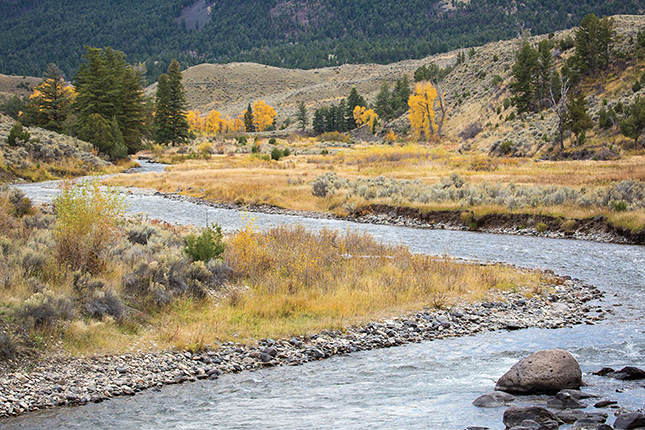Sediment supply predicts river geometry
DOI: 10.1063/PT.3.3588
Gravel-bedded rivers, such as the one pictured here in Yellowstone National Park, are major features of some of the world’s most diverse ecosystems. Understanding rivers’ bankfull geometry—the shape of a river during the stage just before flooding— is an important key to flood management in these regions.

NEAL HERBERT

Typical models for predicting a gravel-bedded river’s geometry rely on a simple assumption: that the flowing water does not generate enough shear stress to move average-sized sediment until the river reaches its bankfull stage. If that assumption holds true, the stable “armor” layer of gravel that makes up the riverbed only shifts once every few years. However, a new paper by Allison Pfeiffer, a graduate student at the University of California, Santa Cruz, shows that many rivers generate much larger amounts of shear stress than standard models predict. Pfeiffer concludes that the amount of sediment being fed into a river is a major and previously unrecognized factor that influences the geometry and mobility of gravel-bedded rivers.
Sediment supply depends on the erosion rate of the surrounding landscape; a high erosion rate means that more rock is eroding from the land’s surface and entering the river. Pfeiffer and coauthors Noah Finnegan and Jane Willenbring compiled data on nearly 350 gravel-bedded rivers in North America and found that rivers with a large sediment supply also experienced large amounts of shear stress. Because high-sediment rivers move gravel more forcefully than the models predict, they probably never form an armoring layer of coarse gravel like their low-sediment counterparts. Instead, their beds are constantly shifting and made of relatively fine-grained gravel.
Significantly, most of the high-sediment, high-shear-stress rivers were located in western North America. Pfeiffer concludes that those rivers, which are often the major channels that carry water from areas prone to landslides, have developed geometries and bed structures that enable them to move a large amount of sediment quickly without becoming blocked. Once the findings are incorporated into geologists’ models, they could have significant implications for civil engineering and ecological preservation. (A. Pfeiffer et al., Proc. Natl. Acad. Sci. USA 114, 3346, 2017, doi:10.1073/pnas.1612907114




